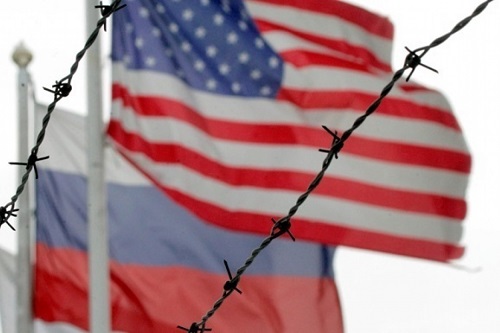Reuters photo
By
Tom Arms
Cold War Memory Lane is being resurfaced with a fresh alphabet soup of nuclear weapons, treaty breaches, renewed bellicosity, cyber attacks and even assassination.
Putin’s Russia has been branded a “pariah state” by British defence Secretary Jeremy Hunt and Kay Bailey Hutchison, Washington’s Permanent Representative to NATO has threatened to “take out” the latest generation of Russian intermediate-range nuclear weapons.
Of course, we are not back in 1945. Then a prostate Western Europe was in danger of being overrun by a Soviet war machine whose authoritarian government made no secret of its aim of overthrowing capitalism and the democratic structures that supported it.
The political and economic collapse of the Soviet Union pushed the frontline between the West and Russia right up against the Russian border. Europe is now an economic powerhouse, although it remains a stunted midget in military terms. It continues to need American protection as much as America needs European markets and political support which is why NATO remains relevant.
The initial American reaction to Soviet aggression in the Cold War was to deploy troops and nuclear capable aircraft in Western Europe as a counter to superior Soviet conventional forces. The message was clear: Attack Western Europe and you will be delayed by conventional forces long enough for atomic bombs to wipe out your cities a la Hiroshima and Nagasaki.
Then the Soviets developed their own atomic/nuclear weapons and the starting pistol for the arms race was fired. In an atmosphere of mutual paranoia and distrust, both sides developed a frightening array of nuclear weapons that could be delivered by aircraft, fired from ships and submarines or mobile land launchers or fixed missile siloes. Both sides refused to slow their pace until they came within sight of the finishing line and saw the terrifying prospect of a nuclear wasteland beyond.
The result was a series of first strategies and then negotiations. First was the Balance of Terror. This was followed by the theory of Mutual Assured Destruction (MAD). Then there was the 1972 Anti-Ballistic Missile Treaty (ABM) which prevented either side from wiping out the other before they could respond (known as first-strike capability). This coincided with and was followed by negotiated limits on the strategic arsenals of the two super powers: The 1972 SALT I (Strategic Arms Limitation) Treaty and the 1979 SALT II Treaty. Then there was the 1987 INF (Intermediate Range Nuclear Forces) Treaty, and finally, as the Soviet Union imploded and collapsed, the 1993 CFE (Conventional Armed Forces in Europe) Treaty and the 1993 CWC (Chemical Weapons Convention) banning the manufacture of chemical weapons.
All of these treaties together were the carefully constructed diplomatic tapestry which helped to bring an end to the Cold War. Then it started to unravel in December 2001. As part of the response to 9/11, George W. Bush announced that the US was withdrawing from the ABM Treaty. He said they needed protection from possible rogue nuclear states. Russia’s parlous economic and political condition dictated a muted response from Moscow. But Russian eyebrows were raised and the move was filed away in the paranoia cabinet, along with the American decision to move conventional forces into Poland and Romania—countries which Moscow has long considered to be their backyard as well as the military front door to the Russian steppes.
In response Putin, in 2008, started to breach the INF Treaty by starting to deploy a series of intermediate-range nuclear Missiles (SSC-8, R-500 and 9K 720 Iskander) with ranges of up to 3,100 miles. Every European country was now threatened. When the Soviets employed the same tactics the US responded with the deployment of cruise and Pershing missiles. These were withdrawn under the terms of the 1987 INF Treaty, and the Russian intermediate range missiles were dismantled.
Communism is no longer the guiding light of the Kremlin. But Russia remains an ideological threat. Marxist-Leninism has been replaced by an authoritarian Russian nationalism led by an oligarchical kleptocracy that needs to dominate Europe and decouple it from America in order to survive in its present form. The deployment of the intermediate-range nuclear weapons along with cyber attacks and assassinations are all part and parcel of a strategy which mirrors that of the Cold War Soviet Union.
Tom Arms
I am a journalist, entrepreneur and historian with extensive experience in print, web and broadcast journalism. I started as a diplomatic correspondent, wrote several books (The Falklands Crisis, World Elections On File and the Encyclopedia of the Cold War), and then in 1987 started my own business (Future Events News Service, www.fensinformation.com) which over 25 years established itself as the world and UK media’s diary. Our strapline was: “We set the world’s news agenda.” I sold FENS in December 2012 but retained the exclusive broadcast rights to all of FENS data. To exploit these rights I set up LookAhead TV which produces unique programmes which “Broadcasts Tomorrow Today” so that viewers can “Plan to Participate.” LookAhead has appeared regularly on Vox Africa, Radio Tatras International, The Conversation and Voice of Africa Radio.
In addition to being a syndicated broadcaster and columnist on global affairs, Tom is also available for speaking engagements and can be contacted on Twitter, Linkedin and email: [email protected].



No Comments Yet!
You can be first to comment this post!